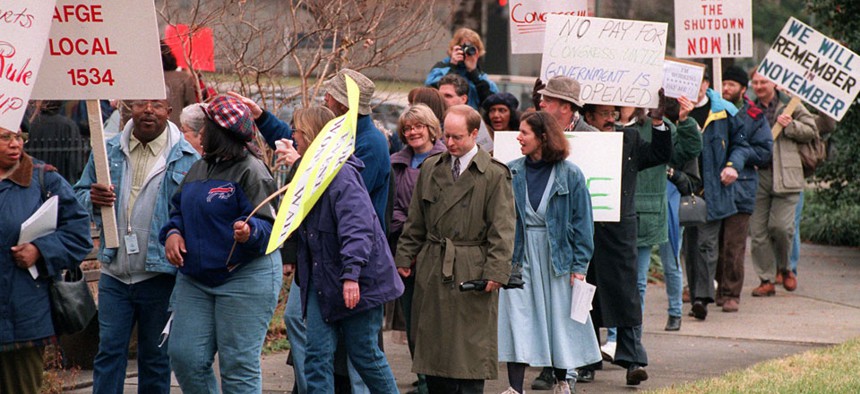
Furloughed federal workers held demonstrations in 1995 when the government was shut down. Dennis Cook/AP file photo
Shutdown Furloughs Would Affect Hundreds of Thousands of Federal Workers
Still, much of the government would remain open if there’s a lapse in appropriations next week.
Roughly 800,000 federal civilian employees would be furloughed if the government shuts down on Oct. 1, according to news reports and data from 2011 -- the last time the government nearly shuttered.
Most federal employees, however, would continue to work if there’s a lapse in appropriations, because the government considers them “essential” workers. The size of the federal workforce, including civilians, Postal Service employees and active-duty service members, is approximately 4.1 million. Of that figure, there are about 1.4 million active-duty military personnel and 2.7 million civilian employees, including the Postal Service.
Active-duty military and about 1.3 million civilian workers are exempt from furloughs in the event of a government shutdown because they have jobs in defense, health care or other areas of national security and/or emergency-related fields. Postal employees also don’t have to worry about unpaid leave because the Postal Service does not depend on annual congressional appropriations.
Political appointees, the president, the vice president, lawmakers and certain legislative staff also are not subject to furlough. In addition, several government services and programs would continue during a shutdown, including Social Security checks to beneficiaries, mail delivery, veterans’ benefits, and customs and border protection.
Deputy Defense Secretary Ashton Carter on Monday told employees to prepare for the possibility of a shutdown, threatening the pay of thousands of civilian workers. “The president and the secretary know that the uncertainty of the current situation puts our civilian workforce in a difficult situation and, should a lapse occur, it could impose hardships on many employees and disrupt important national security projects,” Carter wrote.
In 2011, many of the government’s largest departments exempted a sizable chunk of their workforce from furlough, according to agencies’ 2011 contingency plans as well as a Sept. 24 USA Today analysis of those blueprints. For instance, the Veterans Affairs Department, the second largest agency after Defense, has 312,628 employees, 97 percent of whom would escape furloughs according to USA Today’s analysis. The Homeland Security Department had 232,039 employees as of 2011, according to agency information; of that figure, 195,087 workers would stay on the job if the government shut down.
Defining who is essential and who isn't often becomes the central question for agencies planning for a shutdown -- and the one that most affects which employees receive a paycheck. The Office of Management and Budget and the Office of Personnel Management provide guidance, but it’s up to agencies to determine furlough exemptions. “Agencies are still in the process of reviewing legal requirements and updating their plans,” said Emily Cain, OMB press secretary, in an email. OMB issued guidance last week directing agencies to prepare for a possible shutdown.
Given the time crunch, it’s likely the 2013 plans will look a lot like the 2011 ones, which vary from agency to agency. During a December 1995 review of the previous month's government shutdown, then-Rep. Stephen Horn, R-Calif., said a lack of coordination among agencies created confusion and resulted in a patchwork of operations: “Agencies were left to their own devices, some making decisions to keep employees working if they were paid out of multiyear or no year appropriations, some retaining only those employees involved in protecting life or property. Some departments shutting down almost completely, some remaining fully staffed.”
Essential employees, including active-duty military, are paid since they are working during a furlough, but their paychecks could be delayed, depending on the duration of a shutdown. Federal employees furloughed because of a lapse in appropriations, i.e. a government shutdown, are at the mercy of Congress for any retroactive pay. The last time the government shut down in 1995 and 1996, for 26 days at an overall cost of $1.4 billion, Congress granted retroactive pay to furloughed federal employees for the time they were off the job. Lawmakers might be less inclined to do so in this fiscal climate if the government shuts down next week.
It’s unclear at the moment what will happen, since the House and Senate are still at an impasse over how to fund the government after Sept. 30. Last week, the House passed a temporary spending measure that also defunded President Obama’s health care reform law. The Senate has vowed to strip out any language defunding the 2010 Affordable Care Act, sending the continuing resolution back to the House and leaving little time before Oct. 1 to hammer out an agreement. Obama will veto a measure to keep the government open past Sept. 30 if it reaches his desk in its current form, according to a statement from the White House.
OMB, at least publicly, believes there’s hope. “There is enough time for Congress to prevent a lapse in appropriations, and the administration is willing to work with Congress to enact a short-term continuing resolution to fund critical government operations and allow Congress the time to complete the full year 2014 appropriations,” Cain said by email.







